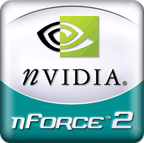nForce2
 | |
| CPU supported | Athlon |
|---|---|
| Socket supported | Socket A |
| Miscellaneous | |
| Release date(s) | July 2002 |
| Predecessor | nForce |
| Successor | nForce3 |
The Nvidia nForce2 chipset was released by Nvidia in July 2002 as a refresh to the original nForce product offering. The nForce2 chipset was a platform for motherboards supporting AMD's Socket A CPUs along with DDR SDRAM.[1] There were multiple variations of the chipset including one with an integrated GeForce4 MX graphics processor (IGP), and one without.
Refresh
[edit]In 2003, Nvidia released a refreshed nForce2, called "nForce2 Ultra 400"[2]. The nForce2 Ultra 400[3] and nForce2 400 presented official support for a 200 MHz FSB and PC-3200 DDR SDRAM, whereas the older nForce2 only supported a maximum of 166 MHz FSB. Ultra 400 offered dual-channel support, while the plain 400 was single-channel PC-3200-capable. Both performed very similarly because neither had the IGP. Athlon XP did not benefit significantly from the added bandwidth because the Athlon XP's bus was only capable of bandwidth matching a single channel of PC-3200. [4]
The new chipset was partnered with several different southbridges, including one with (MCP-T) and one without (MCP) SoundStorm and dual Ethernet NICs. In 2004 three new southbridges were introduced: MCP-S integrated Serial ATA, MCP-RAID had additional RAID-functions and MCP-Gb featured Gigabit Ethernet. These newer southbridges did not integrate the SoundStorm unit nor the dual-Ethernet capabilities of the MCP-T.
See also
[edit]References
[edit]- ^ "Press Release". 2002-08-02. Archived from the original on 2 August 2002. Retrieved 2022-04-04.
- ^ "Nvidia nForce2 Ultra 400 (MCP2-R)".
{{cite web}}: CS1 maint: url-status (link) - ^ Fink, Wesley (May 13, 2004). "A Closer Look at nForce2 Ultra 400Gb".
- ^ Gasior, Geoff (2004-05-10). "NVIDIA's nForce2 Ultra 400Gb chipset". The Tech Report. Retrieved 2024-09-06.
